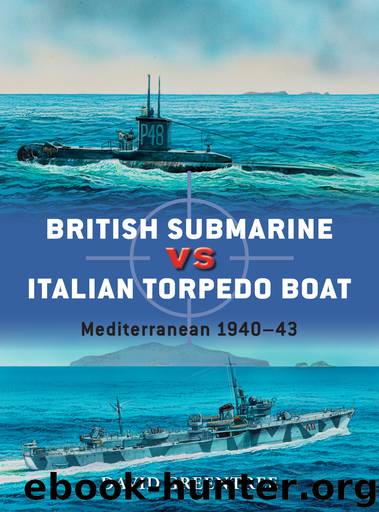British Submarine vs Italian Torpedo Boat by David Greentree

Author:David Greentree
Language: eng
Format: epub
ISBN: 9781472814142
Publisher: Bloomsbury Publishing
Published: 2016-02-28T16:00:00+00:00
BRITISH SUBMARINERS
CHARLES ANSCOMB
A boy sailor, Anscomb realized that ‘The strict discipline and formality of life in a big ship may suit some men whose minds are set that way’ (Anscomb 1957: 22), but he wanted to use his initiative and smaller ships, including submarines, held greater appeal for him. In 1928 he volunteered for submarines, but had to do three more years’ General Service. In 1932 he started submarine training, and was told by an instructor: ‘Each man in a submarine has a responsible job, and only the best men, those with real initiative, are good enough for us’ (Anscomb 1957: 27). After four weeks of training studying how the valves and wheels controlled the submarine, Anscomb had a practical exam under the captain’s gaze on operating the hydroplanes for depth and angle, and a written exam. He passed, and joined his first submarine. He soon moved on to Sturgeon. He was drafted to Pandora in Hong Kong and served in the torpedo compartment before moving to Porpoise in 1935. He then moved to Sterlet as the coxswain and in 1939 to Parthian in Hong Kong. Parthian arrived in Egypt in April 1940, one of 17 boats that arrived in Egypt that year.
Anscomb moved to Tempest in August 1941 as the coxswain, and later described how Tempest’s hydroplanes ‘were a dream of precision and dependability after Parthian’s temperamental old flippers’ (Anscomb 1957: 106). He described the boat as ‘purely a lethal weapon, a precision tool for destruction’, where crew comfort and storage space were trumped by ‘the demands of more and better machinery and a smoother deadlier performance’ (Anscomb 1957: 106). He was taken prisoner following the sinking of Tempest on 13 February 1942. After the war he served for a short time as an instructor before retiring.
ALASTAIR MARS
Mars entered the Royal Navy as a cadet in 1932 and joined his first submarine in 1936. Before World War II he served on Swordfish and Regulus, and in November 1941 was appointed captain of Unbroken. Upon assuming command he told his crew: ‘I am the sole arbiter of what is good for you, and my orders are to be obeyed implicitly … You will learn more discipline with me than you dreamed of – the proper sort of discipline: self-discipline’ (Mars 2008: 16). He told them that ‘a bad order well executed leads to a better result than a good order ruined by indecision … a slackly obeyed order leads to confusion. In a submarine confusion means disaster’ (Mars 2008: 16).
After a failed patrol on Unbroken in November 1942, Mars had nagging doubts and told Simpson he ‘was good for perhaps four more patrols, but could not guarantee my nerves and strength beyond that’ (Mars 1971: 200). Horton had told Simpson that tour length would be limited to a year for a submarine. Unbroken remained in the Mediterranean for four more months, but Mars was sent home. He ‘felt guilty at having to leave behind the officers and men of my crew’ (Mars 1971: 208), but believed it was the right decision.
Download
This site does not store any files on its server. We only index and link to content provided by other sites. Please contact the content providers to delete copyright contents if any and email us, we'll remove relevant links or contents immediately.
| Automotive | Engineering |
| Transportation |
The Truth About The Titanic by Archibald Gracie(916)
1805 by Richard Woodman(851)
05 Marine by Tom Clancy(840)
The Ship of Dreams by Gareth Russell(754)
The Art of Rigging by George Biddlecombe(749)
Patriot Pirates by Robert H. Patton(711)
Marine by Tom Clancy(709)
Villains of All Nations by Marcus Rediker(706)
Batavia by Peter FitzSimons(682)
The Last Time Around Cape Horn by William F. Stark(676)
8.4 by Peter Hernon(655)
The Imperial Japanese Navy in the Pacific War by Mark Stille(628)
Pirate Hunter of the Caribbean by David Cordingly(615)
Unsinkable: The Full Story of the RMS Titanic by Daniel Allen Butler(600)
Sailing Alone Around the World (Barnes & Noble Classics Series) by Joshua Slocum(587)
Voices from the Titanic by Geoff Tibballs(565)
The Perfect Storm: A True Story of Men Against the Sea by Sebastian Junger(554)
The Last Night on the Titanic by Veronica Hinke(551)
01 The Sea Hunters by Clive Cussler & Craig Dirgo(546)
